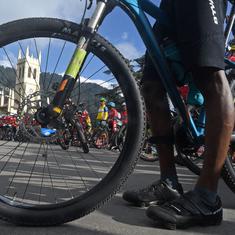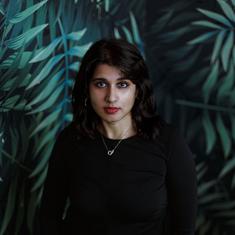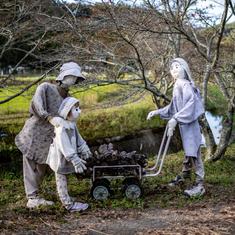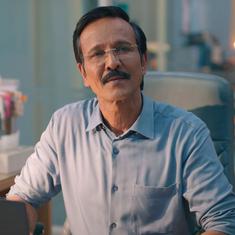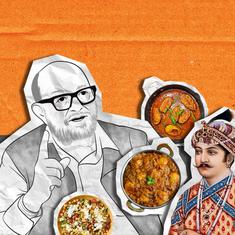“Not an obituary. We cannot write an obituary about an ‘idea’ that illuminated so many generations transcending geopolitical borders,” as my friend and journalist Pooja Mitra so eloquently puts it.
Celebrating instead his love for truth and justice and generosity by sharing a suite of his Venice poems with my photographs of Venice. The photographs do not in anyway interpret the poems. Nor were the poems written for the photographs! At different moments in time both. The only common factor was his “choosing to like” the nocturnal ones from a host of many.
From:ngugi@uci.edu
To:Naveen Kishore
Sat, 24 Aug, 2019 at 12:47 pm
Dear Naveen
And yes, please let us share our take on Venice! The camera and the pen on Venice!!!
Best
Ngugi

The thing about cities like Venice is their singularity. Nothing quite like it exists. Night-time Venice empties itself of people. And becomes shadow. Unlike other “nights” in “other” cities there is a resigned melancholy to these shadows. Not furtive. Or filled with the “scurry-home” that accompanies fear. Just a combination of light and shade that causes these shadows into being. Almost a nightly re-birth. For the day-time brings bustle. And the Babel of languages carried by each individual traveller-tourist. The night is safe in the absence of sound.
Unless you listen to the sound of your own feet returning home.
— Naveen Kishore.
From:ngugi@uci.edu
To:Naveen Kishore
Wed, 21 Oct, 2020 at 11:28 pm
Dear Naveen
Your mind and soul churn out image after image.
There is one engine that has no arrival,
It steams image after image, like you.
Art is a journey without an end, because
Because it continues its self-resurrection
Into new selves
Look at the guy called Shakespeare
Still talking to us
Or the unknown numerous others
Like them that authored Mahabharata
Art knows not death.
Art contains arrival and departure.

Venice, Italy
Home to churches pigeons gondolas and boats on waterways
San Marco to Salute I never have seen so many shrines of worship in one city
Inside the boats, tourists press against one another or
Push and shove on bridges linking the islands that make Venice.
Enter a restaurant or
Any shop selling all manner of wares and masks
Cacophonous tongues of the globe accost you
They’re from Asia, Africa, Europe to the Americas.
Though Venice is Italyland
It’s the outnumbered Italian that sounds foreign.
With eager eyes and smartphones
Tourists run about capturing images:
They take them home to tell titillating tales of La Serenissima and
Wondrous paintings and sculptures decorating Venetian palaces
La Serenissima
Venice Venice Venice
You have stolen hearts of writers from many lands
Which have given birth to great literature.
Shakespeare penned The Merchant of Venice and
The tale of Othello, the black hero of ancient Venice.
Thomas Mann, the German, dreamt up Death in Venice.
From Goethe, Henry James to Italo Calvino they’ve told stories.
So I, Ngũgĩ, will also weave one or two in Gĩkũyũ
To remind the world that the African sweat also built Venice
The way it did other European cities:
Amsterdam Copenhagen London Lisbon Madrid Paris Stockholm
Venice Venice Venice three times I call you to make sure you hear:
Your serenity might lull one into forgetting
It hides a history of the blood you once enslaved.
Quick Judgment
In a restaurant near my place in Campo San Samuele I told them
I wanted their specialty, so that
On returning home to Africa I would sing gloria to the taste of Italian food.
They brought me fish and spaghetti with black ink all over it.
What kind of people are these?
They flood my food with black ink just because I am black?
I walked back to Campo San Samuele angry and hungry.
Another day my guide Lucio De Capitani took me to Trattoria da Jonny.
I ordered lamb and hastened to tell them not to add anything to the meal.
Lucio de Capitani asked for the dish he loved most.
They brought him fish and spaghetti flooded with black ink.
This is the most beloved dish in Venice, he told me, and
The black ink is what we love most.
It is not pen ink;
It is a black liquid squeezed out of a squid.
Bridges of Locked Love
Venice is home to hundreds of islands
Linked by numerous bridges.
Rialto Bridge; Bridge of Sighs; Academy ; and
The Devil’s Bridge all have stories to tell.
Brides and Bridegrooms come from far and wide
China, Japan or Korea;
They exchange rings and take selfies at their favourite bridge.
Lovers descend from all corners of the globe,
Pour their love and vows into a padlock,
They hang the locks on the bridge and throw the key into the river
So their love will remain locked together forever.
The bridges hang low under the weight of locked love.
But the one I recall more clearly is the Bridge of Sighs:
It links Doge’s Palace and the New Prison on Piazza San Marco.
The wealthy stand on the bridge and sigh with satisfaction
The victims of wealth stand on the bridge and sigh with sorrow.
Ponte del Diavolo, Venice
Legend has it that once,
With Venice and Vienna at War,
A daughter of Venice and
A son of Vienna, a soldier,
Felt their hearts rebel against war.
They decided to cross the valley of hate, and
Swim in the warm waters of love.
The family side of the daughter killed the soldier.
The girl was left with a bleeding heart.
A Healer took her to the devil
Who brought back her man to life, but
The Devil demanded his fee:
On the night before Christmas,
The healer was to bring him, at the bridge, souls of the recent dead.
Death came for the Healer too soon.
When the Devil went to the bridge he did not get his due.
Every year when that day comes a cat prowls the bridge, but
It is the devil disguised as a cat
Waiting for the healer to bring him souls of the recent dead.
All he hears are the murmurings of the flowing waters:
Flow flawless love flow.
Love makes the soul soar
Hate makes the soul sink
Flow love flow flawlessly
Spread One love to all the earth
You Devil Go away.
Let love to rule the world.
Moulaye Niang, Venice
I met Moulaye in his factory at Salizadar Del Pignater
Burning Murano glass with flaming gas.
He made beads; he made necklaces; he made earrings.
As he moulded different shapes, he composed lullabies
A soul on fire whispering soul into the soul of fire.
He reminded me of Prometheus
Who once stole fire, for the humans,
From the seat of the Gods above. The fire
Gave humans the light and the power of making things.
This Prometheus is Othello’s country man.
He comes from Senegal, West Africa.
He changes Murano glass into marvels of colorful shapes.
This Senegalese glass artist also sings.
The light and sounds of Africa are everywhere.
Resurrection in Venice
I met Othello in Venice but
Not the one from Shakespeare
Who worked for them
Fought their wars
Crushed their enemies
In defence of Venice.
He let Iago’s lies
Born of racism
Get under his skin into his heart and head.
He snuffed the life of Desdemona his love
And then took his own,
Freeing his soul to follow his love.
I met Othello in Venice but
Not the one painted by Vittore Capaccio
Piloting the Venetian gondolas
Gliding along their waterways
The many canals small and wide
On all sides of the Grand Canal.
The affluent of Venice felt so good about the ride
Which took them to Piazza del Marco and back
Feeding their eyes on the architectural wonders
Renaissance and Gothic Palaces lined on either side.
I met Othello in Venice but
Not the one in Bellini’s Miracle of the Cross
Thrown into the river below the Bridge of S.Lorenzo
To retrieve the remnant of the True Cross.
Desperately he fights the waves in order not to drown.
The lady of the house looks on from the window above in delight.
I met Othello in Venice but
Not the one in the ten sculptures
That line the walls of Ca’Rezzonico
Rented by Ca’Foscari University of Venice for our banquet,
Chains still around the slaves’ legs and necks.
I ask:
Are these sculptures here to celebrate slavery or
To remind people that
What they now eat and drink are fruits of those
Once snatched from the mouth of hungry and thirsty slaves?
I met Othello in Venice but
Not the one painted on the floor of the entrance into Moresco Hotel,
On Fondamenta del Passamonte between Rio Nuovo and Rialto Bridge,
Near the Peggy Guggenheim Arts Museum.
As guests enter, they step on the painting,
And deposit the dust and mud from their shoes.
No, not this or that Othello.
The Othello I met is named Peter Kariũki.
Ten years old and black,
He organises other boys to play his version of basketball.
At Campo de le Gate
They bounce balls on the floor and shoot into the basket.
He ensures they follow the rules and work in harmony.
His bright eyes light up as if
They can see into tomorrow and the days after:
My mother and father are black and come from Limuru, Kenya
They gave me life born of love;
My mother and father are white and come from Venice, Italy
They gave me life born of love.
I was born in Limuru
I grew up in Venice
In me Kenya and Italy are conjoined.
They call me Peter Kariũki
The one who resurrects understanding among peoples
No matter the color of their skin or
The land of their origins and migrations.

Courtesy Naveen Kishore, publisher, Seagull Books.
All poems translated by the author from the Gĩkũyũ.
All photographs by Naveen Kishore.

